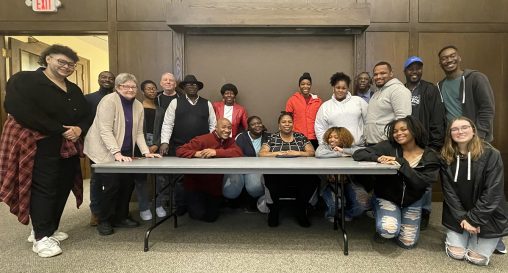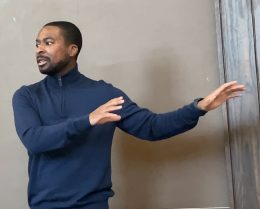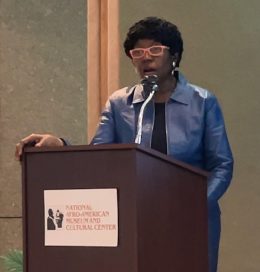
Wright State students visited sites in Ohio that were important to the Civil Rights Movement during a bus trip for the course The Roots of the American Civil Rights Movement in the Midwest and Heartland taught by Tracy Snipe, professor of political science.
A Wright State University bus trip around Ohio was not the usual tourist excursion. It focused on past and present events in the Civil Rights Movement — and left a powerful impression on Wright State students.
Tracy Snipe, Ph.D., professor of political science in Wright State’s School of Social Sciences and International Studies, organized the March 31–April 1 civil rights pilgrimage to complement his class The Roots of the American Civil Rights Movement in the Midwest and Heartland.
He said the mission of the trip — which was primarily organized for students but included others in the Wright State and local communities — was to show that Ohio played a role in the Civil Rights Movement of the 1950s and 1960s.
Snipe said one student noted that the South comes to mind when talking about the Civil Rights Movement. “The student said the trip changed her viewpoint — which is what I was trying to accomplish,” he said.

State Rep. Willis E. Blackshear Jr., a Wright State graduate from Dayton, addressed the students at the National Underground Railroad Freedom Center in Cincinnati.
The group’s first stop was the National Afro-American Museum and Cultural Center in Wilberforce. The second stop was at Miami University in Oxford, site of the former Western College for Women, where in 1964 volunteers for the civil rights initiative called Freedom Summer trained. The third stop was the National Underground Railroad Freedom Center in Cincinnati.
On the bus through an arrangement by Snipe, a South Carolina native, was Blondelle Gadsden, a relative of one of the nine people in a prayer group fatally shot at Mother Emanuel A.M.E. Church in Charleston, South Carolina, in 2015. Snipe said she shared her insights into modern civil rights struggles and her sense of connectedness to Wilberforce.
The bus returned to Wright State, exchanged some passengers, then left for Cleveland for an overnight stay. The next morning the pilgrimage continued to the East Cleveland Public Library, where the troupe met Samaria Rice, mother of Tamir Rice, the 14-year-old boy fatally shot in 2014 by Cleveland police who mistook his toy gun for a real one.
“She was the speaker who made the most of an impression,” Snipe said of Rice. “She talked about the past importance of the movement and the present-day struggle. She captured what I wanted in this experience.”
“The part of the trip that made the biggest impression on me was the speech given by Samaria Rice,” said Sierra Maben, a senior communication major with a focus in media studies from Oberlin. “She is such an amazing and strong woman. Samaria has not given up the fight for justice for her son and laws relating to such sickening tragedies.”
The last stop was at the Rock & Roll Hall of Fame. The bus returned to Wright State that evening.
“All the sites had a great impression on me in different aspects,” said Miannah Lawrence, an urban affair major and studio art minor from Dayton who expects to graduate this summer. “As an artist and creative, the National Afro-American Museum and Cultural Center had a deep impression on me. I also enjoyed the “Queens of the Heartland” exhibit showcasing 30 Black women who were architects of change, having ties to Ohio by birth or choice. Seeing the various paths these women excelled in and reading about their stories gave me inspiration.”

Blondelle Gadsden, a relative of one of the nine people in a prayer group fatally shot at Mother Emanuel A.M.E. Church in Charleston, South Carolina, in 2015, joined the bus trip.
Snipe said an added benefit of the trip was “the ability to interact closely with professors and other students — the ability to have prolonged interaction and bonding experiences.”
“Being surrounded by amazing peers who uplift you and experience these things in real-time with you is unmatched,” said Maben, who expects to graduate in December. “There was so much culture experienced throughout this pilgrimage. It was nothing short of inspiring.”
“The civil rights pilgrimage created a space for learning, vulnerability, enlightenment and discussion,” Lawrence said.
She said it was emotional “but also eye-opening and a breath of fresh air. It encompassed many aspects of the Civil Rights Movement that often get overlooked in the Midwest, and Ohio specifically.”
Snipe said he may organize a similar trip next spring.

 Milling around
Milling around  Wright State recognizes Nursing Professor Kim Ringo for advancing international student success
Wright State recognizes Nursing Professor Kim Ringo for advancing international student success  Wright State honors graduating students for distinguished doctoral dissertations
Wright State honors graduating students for distinguished doctoral dissertations  Top 10 Newsroom videos of 2025
Top 10 Newsroom videos of 2025  Museum-quality replica of historic Hawthorn Hill donated to Wright State
Museum-quality replica of historic Hawthorn Hill donated to Wright State 